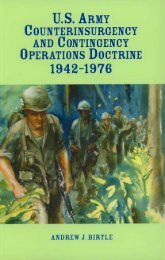C. Wiebes - Intelligence en de oorlog in Bosnië 1992-1995. De rol van de inlichtingen- en veiligheidsdiensten - Engels
C. Wiebes - Intelligence en de oorlog in Bosnië 1992-1995. De rol van de inlichtingen- en veiligheidsdiensten - Engels
C. Wiebes - Intelligence en de oorlog in Bosnië 1992-1995. De rol van de inlichtingen- en veiligheidsdiensten - Engels
- No tags were found...
Create successful ePaper yourself
Turn your PDF publications into a flip-book with our unique Google optimized e-Paper software.
76Forces were said to have received permission to use UNHCR jeeps with special number plates for theiroperations. 360 Accord<strong>in</strong>g to an <strong>in</strong>ternal <strong>in</strong>vestigation by UNHCR <strong>in</strong> May 1993, the Bosnian Muslimsalso repeatedly smuggled ammunition <strong>in</strong> aid convoys. For <strong>in</strong>stance, 30,000 American camouflageuniforms were said to have be<strong>en</strong> transported by the UNHCR to the ABiH 2nd Corps. 361 A load ofweapons and ammunition was also discovered <strong>in</strong> an aid convoy of the Caritas organization on the wayto Busovaca <strong>in</strong> March 1993. Whether this was a <strong>de</strong>liberate Bosnian-Serb attempt to discreditUNPROFOR, or a similar attempt by the Bosnian Croats, rema<strong>in</strong>ed unclear. 362 The VRS was later todiscover DM 30,000 <strong>in</strong> an NGO convoy bound for Goraz<strong>de</strong>. 363Accord<strong>in</strong>g to an UNMO official, from an <strong>in</strong>tellig<strong>en</strong>ce po<strong>in</strong>t of view, ‘the most <strong>in</strong>terest<strong>in</strong>g’organizations were the NGOs. Personnel of NGOs were therefore oft<strong>en</strong> recruited by <strong>in</strong>tellig<strong>en</strong>ceservices, because a variety of relief organizations were able to travel to provi<strong>de</strong> humanitarian aid <strong>in</strong>areas that were closed to the outsi<strong>de</strong> world. Meanwhile, the ABiH also drove around <strong>in</strong> trucks markedwith NGO stickers, and which proclaimed ‘scottish European Aid’, ‘UNHCR’, or ‘European Aid’. 364An American <strong>in</strong>tellig<strong>en</strong>ce service ev<strong>en</strong> recruited ag<strong>en</strong>ts <strong>in</strong> one of the NGOs that worked <strong>in</strong>Srebr<strong>en</strong>ica. 365 It also became evid<strong>en</strong>t dur<strong>in</strong>g the fall of Srebr<strong>en</strong>ica that NGOs and a variety of otherrelief organizations supplied reliable <strong>in</strong>tellig<strong>en</strong>ce. Officials from the American <strong>in</strong>tellig<strong>en</strong>ce community<strong>de</strong>clared at the time that ‘their best <strong>in</strong>formation came from human rights groups, the United Nationsand the press, not from spies, satellites or eavesdropp<strong>in</strong>g’. 366In other words, many <strong>in</strong>tellig<strong>en</strong>ce services <strong>in</strong> particular were repres<strong>en</strong>ted <strong>in</strong> UNPROFOR <strong>in</strong>various cities and areas <strong>in</strong> Bosnia. However, the above also reveals that the American services were notthe only ones that were active. Other services likewise had sources and ag<strong>en</strong>ts locally, and this was alsotrue of <strong>in</strong>tellig<strong>en</strong>ce services from countries like Russia, Turkey, Greece and Iran. The functions of thes<strong>en</strong>ational elem<strong>en</strong>ts were oft<strong>en</strong> unrelated to any support to an UN ag<strong>en</strong>da. These nationalities worked tosupport their own ag<strong>en</strong>da’s, and some of those <strong>in</strong>terests overlapped with on-go<strong>in</strong>g Western efforts.However, where it ma<strong>de</strong> good s<strong>en</strong>se to do so, some cooperation with these services was permitted on acase-by-case basis. Whether this was also true of the Dutch <strong>in</strong>tellig<strong>en</strong>ce community will be discussed <strong>in</strong>the next chapter. After all, it is rele<strong>van</strong>t to know whether the Dutch <strong>in</strong>tellig<strong>en</strong>ce and security serviceswere also active <strong>in</strong> this grand <strong>in</strong>tellig<strong>en</strong>ce ‘theme park’. How well prepared was the Netherlands <strong>in</strong> thearea of Hum<strong>in</strong>t, Sig<strong>in</strong>t and Os<strong>in</strong>t? Did it have suffici<strong>en</strong>t technical, personnel and f<strong>in</strong>ancial resources to‘tackle’ the crisis <strong>in</strong> Bosnia and to provi<strong>de</strong> Dutchbat with suffici<strong>en</strong>t <strong>in</strong>tellig<strong>en</strong>ce support?5. ConclusionsThe UN was extremely wary of active and focused gather<strong>in</strong>g of <strong>in</strong>tellig<strong>en</strong>ce, and UNPROFOR itself asan organization had no well-organized structure for gather<strong>in</strong>g <strong>in</strong>tellig<strong>en</strong>ce. This meant almostautomatically that not only the United States, but also the countries that contributed troops to thispeacekeep<strong>in</strong>g operation, started to gather <strong>in</strong>tellig<strong>en</strong>ce <strong>in</strong><strong>de</strong>p<strong>en</strong>d<strong>en</strong>tly. This was carried out not only bythe <strong>in</strong>tellig<strong>en</strong>ce services from the differ<strong>en</strong>t national capitals, but also <strong>in</strong> the region itself. By harness<strong>in</strong>gall possible resources and <strong>de</strong>ploy<strong>in</strong>g more people, the services tried to ga<strong>in</strong> a view of the political,economic and military <strong>de</strong>velopm<strong>en</strong>ts <strong>in</strong> the region. As <strong>de</strong>scribed above, there were <strong>in</strong>itially a variety ofteeth<strong>in</strong>g troubles, which were psychological, political, structural and technical <strong>in</strong> nature.360 Harald Doornbos, ‘Gro<strong>en</strong>e spionn<strong>en</strong> tuss<strong>en</strong> blauwhelm<strong>en</strong>’ (‘Gre<strong>en</strong> spies among blue helmets’), <strong>De</strong> Stem, 10/05/95. Seealso: US Special Operations Command, 10 th Anniversary History, MacDill AFB, Florida, 1997, pp. 52-55.361 MoD, MIS/CO, <strong>De</strong>velopm<strong>en</strong>ts <strong>in</strong> the former Yugoslav fe<strong>de</strong>ration, no. 32/93, 10/05/93 and 101. MISCie. Van Jawad toHakort, <strong>de</strong>brief<strong>in</strong>g report 101 MIScie, 23/12/95.362 MoD, MIS/CO, <strong>De</strong>velopm<strong>en</strong>ts <strong>in</strong> the former Yugoslav fe<strong>de</strong>ration, no. 18/93, 25/03/93.363 Corw<strong>in</strong>, Dubious Mandate, p. 183.364 UNGE, UNPROFOR, No. 330-6, G-2 HQ SNE to BHC, Zagreb, no. 2725, 08/01/95.365 Confid<strong>en</strong>tial <strong>in</strong>terview (54).366 Steph<strong>en</strong> Engelberg & Tim We<strong>in</strong>er, ‘The Days of Slaughter’, The New York Times, 29/10/95.





